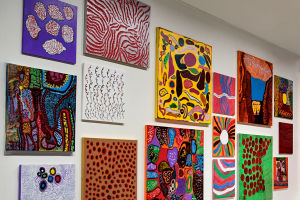When Salvador Dalí first burst onto the art scene in the 1920s, the world was captivated by his vivid, strange, and often perplexing imagery.
His surrealist paintings didn't just challenge artistic norms—they seemed to invite us into a dreamlike state, where logic and reality held no sway.
But one question has lingered for decades: Can dreams truly be painted? Dalí certainly thought so. In fact, his entire career was dedicated to bringing the elusive, fantastical world of dreams to life on canvas. But how did he do it, and what does his work reveal about the intersection of the unconscious mind and artistic expression?
The Surrealist Movement: Art Beyond Reason
To understand Dalí's approach to painting dreams, we need to step back and consider the movement he became synonymous with: Surrealism. Originating in the early 20th century, Surrealism sought to bypass the logical, conscious mind and delve directly into the unconscious.
Surrealists believed that the most profound truths of the human experience could be accessed through the exploration of dreams, fantasies, and the irrational. Dalí was one of the movement's most fervent believers, seeing dreams as a direct link to a hidden reality beyond our waking minds. He famously declared, "I am not afraid of any real situation. I am only afraid of the unconscious." For Dalí, dreams were not a mere escape from reality—they were a higher form of truth.
Dalí's Dreamscapes: The Intersection of Fantasy and Reality
In Dalí's paintings, the boundaries between the conscious and unconscious are often blurred, creating landscapes where logic and time collapse. His most iconic work, The Persistence of Memory (1931), features melting clocks draped over tree branches and soft surfaces, defying the rigid, structured nature of time as we know it. This distorted perception of time is a direct reflection of the way we experience it in dreams—fluid, erratic, and untethered to conventional rules.
Dalí used a technique he called "paranoiac-critical method" to translate his dreams onto canvas. This method involved inducing a state of paranoia and irrationality, allowing his subconscious to take control of the painting process. By engaging with his inner fears and desires, Dalí was able to manifest images that felt like fragments of a dream—disturbing yet strangely beautiful.
He believed this approach allowed him to access his unconscious thoughts and express them visually in a way that was both personal and universally relatable.
Dreams or Nightmares? The Disturbing Beauty of Dalí's Vision
Dalí's dream-inspired works were not always comforting. In fact, many of them exude a sense of unease and anxiety.
One of his recurring motifs, the "melting" or "softening" of objects, suggests a dissolution of reality, a common experience in dreams where objects lose their rigid forms. For instance, The Persistence of Memory captures the eeriness of time slipping away in a way that feels simultaneously familiar and alien. Similarly, Dream Caused by the Flight of a Bee Around a Pomegranate a Second Before Awakening (1944) features a woman being attacked by surreal, dreamlike creatures that are impossible to interpret logically.
This uneasy quality of Dalí's work speaks to the dual nature of dreams: they are often beautiful but can also be deeply unsettling. His imagery taps into the subconscious fears, desires, and anxieties that emerge in dreams, transforming them into tangible forms that we can contemplate and analyze. Dalí wasn't just painting a literal representation of dreams—he was painting the feeling of dreaming itself, where logic unravels and the irrational reigns.
Can Dreams Truly Be Painted? The Role of the Unconscious
While Dalí's ability to translate the intangible into a visual form may seem magical, it raises the larger question: Can dreams truly be painted? To some, Dalí's works might feel like mere representations of his own unconscious thoughts and experiences. But to others, they represent something deeper—an attempt to capture the essence of what it means to dream.
Dreams are notoriously difficult to pin down. They are fluid, shifting, and often defy interpretation. In many ways, Dalí's surrealism does the same. His works don't just depict dreams; they evoke the disorienting, strange, and mysterious quality of the dream state. The blending of the real with the imaginary in Dalí's work is an attempt to manifest the illogical and inexplicable elements of dreams in a way that feels both authentic and provocative.
What makes Dalí's work compelling isn't just his ability to depict dreamlike images—it's the way he manages to capture the feeling of dreaming: the sudden leaps of logic, the haunting symbolism, and the sense of mystery that persists even after we wake up.
The Lasting Impact of Dalí's Dream Art
Dalí's exploration of dreams had a profound impact on the art world, influencing not only surrealism but also modern art movements. His ability to blend reality with the fantastical paved the way for future artists to explore the subconscious and the irrational. His dreamscapes are more than just bizarre images; they are windows into the unconscious mind, where nothing is quite what it seems, and everything is open to interpretation.
In the years since Dalí's death, his works have continued to captivate audiences and spark conversations about the nature of dreams and the unconscious. His legacy reminds us that the boundary between reality and dream is far more porous than we might like to admit. Dalí, with his vivid imagination and mastery of surrealist technique, proved that dreams can indeed be painted—not in the sense of literal depictions, but as an exploration of the mysterious, often illogical world we enter every time we close our eyes.
Dreams as the Canvas of the Mind
So, can dreams truly be painted? Dalí would argue that they can—just not in the way we might expect. His surrealist masterpieces invite us to step into the dream world, where the subconscious mind is free to roam and explore the deepest recesses of human thought.
Through his distinctive use of symbolism, distortion, and dreamlike imagery, Dalí captured the essence of what it feels like to dream. His art is an invitation to embrace the unknown, to surrender to the mysteries of the mind, and to see the world through the lens of the unconscious.
For Dalí, dreams were not just fleeting images—they were powerful forces capable of reshaping the world. And through his paintings, he shared this transformative vision with the world, forever altering the way we think about the intersection of art and the unconscious.


